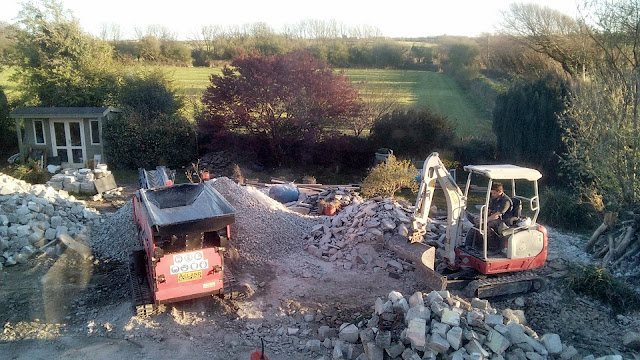After knocking down the house, we were left with somewhere in the region of 100-150 tonnes of rubble. We originally made some enquiries about having it all taken away, but that would be expensive. And we still needed to bring the ground level up around the house, which would mean paying again to bring more hardcore in.
So the obvious solution seemed to be for us to crush all the rubble into usable hardcore... the only problem was that we had no experience of doing any of that. We did try to get a specialist firm in, but after they messed us around continually for weeks we gave up and resigned ourselves to yet again having to do everything on our own.
Getting a crusher was tricky. Not many hire companies have them and we live in a pretty isolated area so most firms that actually stocked them refused to deliver to us. Eventually we found a company that agreed to supply us and after booking a week off work, we took delivery of the crusher.
A local hire firm also supplied us with a (rather battered) mini-dumper...
... and a 1.5 tonne mini-digger. So we were all set.
This was going to be nerve-wracking. The crusher was brand new and we had no experience of using this type of machine; any dents or scrapes would lead to a hefty fine and lost deposit.
The crusher was 'driven' via a large remote control unit. We didn't have much room to manoeuvre the vehicle, so threading it around the narrow side path to the back garden was a tricky undertaking and we had to trim a few tree branches to squeeze it in.
It felt a bit like one of those sliding puzzle games; the piles of rubble would all have to be crushed in the right order, otherwise we wouldn't be able to get the crusher around the back of the garden.
This massive stack of rubble was blocking our path so would have to be cleared first.
The lack of space made it awkward to get the digger into position too.
A view from the driving seat of the digger. We loaded the blocks into the top of the crusher and a continuous stream of crushed material would pour off the end of the conveyor belt.
Initially we loaded the crushed material directly into the mini-dumper...
... and then drove each load around to the front of the house...
... gradually spreading the crushed material along the way.
This worked alright for a while, but then disaster struck. The mini-dumper ground to a halt with damage to its caterpillar tracks.
The hire company initially tried to blame us for the damage, but we argued the dumper was simply not fit for purpose. It was delivered in terrible condition, was a struggle to even get the engine started and it fell apart after just a day's light use.
... though we were still left with enormous piles of crushed stone. The dumper had been repaired but with only a week off work to get the crushing done, we weren't going to have time to spread all the material around the site too.
Luckily the site inspector chipped in with all the hard work and assisted with the driving of the digger. Unfortunately his arms weren't long enough to reach the controls, but full marks for trying.
After a week of solid work, we'd got rid of all the huge piles of rubble... and replaced them with huge piles of hardcore! Still at least we'd turned the old house into some usable materials that we could recycle to raise levels all around the house.
Although covered in cement dust, the house already looked so much better with a bit of clear space around it. For the first time since it was built, the house didn't feel shoe-horned into the site and looked like it could finally 'breathe'.
























